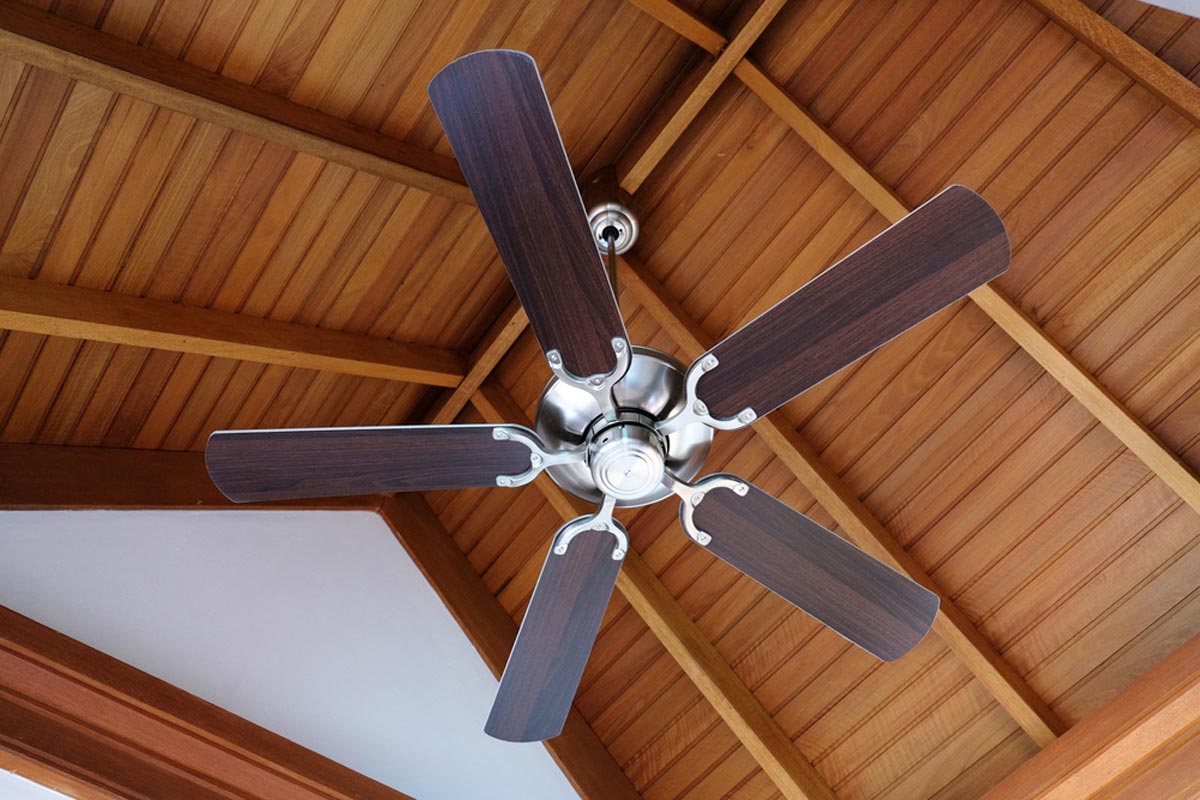Before you head off to the hardware store and pick up that shiny new ceiling fan, you will want to consider several vital factors before installation.
There are many variables you may not have thought of, such as the fan’s type, size and speed, and even energy-saving and efficiency concerns.
A bit of expert advice will go a long way and can save you time and money down the road.
Would you prefer professional help? Schedule an appointment for a ceiling fan consultation in Sydney to get one of our expert technicians to do the work for you and help you determine the best type of ceiling fan for your space.
Types of The Ceiling Fan
There are three main types of fans to choose from. Knowing which type you are planning to purchase will give you a better idea of what kind of outlet box is needed. This is also helpful knowledge to pass on to your electrician beforehand if you plan on hiring one.
Outdoor Ceiling Fans
An outdoor ceiling fan is a wonderful addition to a patio, deck, or porch. These fans need to be heavy-duty to withstand weather and UV rays, so purchasing a higher quality fan is recommended. There are many models available for purchase that come with a lifetime warranty. So, before purchasing, check the warranty on the fan.
Indoor Ceiling Fans
When considering an indoor fan, you will need to measure and see how much clearance your ceiling has from the floor. For safety purposes, Australian ceiling fans require a clearance of 2.1 m from floor to blades. However, some low-profile models cater to rooms with less clearance.
For spaces with tall ceilings, you can purchase extension rods. Just ensure that you leave enough room for safety.
Ceiling Fans with LED Lights
A combination fan with a LED light fixture is an excellent option to both circulate the air and light your room. You can even get a fan with a remote control that controls the fan speed and light brightness.
Speed of The Ceiling Fan
Speed is a huge factor when choosing a fan. You’ll want to take a keen look at the fan’s cubic feet per minute (CFM). This measures how much air is moved by the fan.
Recommended CFM sizing per room space:
- CFM rating of 1,000-3,000 for small spaces, bathrooms, and small bedrooms
- CFM rating of 1,600-4,500 for medium bedrooms, kitchens, and dens
- CFM rating of 2,300-6,500 or more for large rooms and small garages
Here is a handy calculator that converts CFM into metric measurements.
Size of The Ceiling Fan
Blade sizes vary greatly and dictate how much air is being circulated. The larger the blade fans, the more air movement, allowing for better circulation.
It is essential to watch the weight of the ceiling fan that you choose, as a heavier fan will require more substantial outlet box brackets.
Recommended blade sizes per room space:
- Blade span under 110 cm for small spaces, bathrooms, and small bedrooms
- Blade span between 110-127 cm for medium bedrooms, kitchens, and dens
- Blade span of 127 cm or more for large rooms and small garages
Fan Style and Location
There are endless styles of fans available on the market. Fans that have long blades have a more luxurious and exotic look. You will find long blade ceiling fans frequently in India. Cheaper ceiling fan blades are usually made of particleboard or plastic, whereas higher-end fan blades are made of hardwood and vinyl. You can get fans with as little as two blades all the way up to nine blades.
You should always install ceiling fans in the centre of the ceiling. For angled and vaulted ceilings, you can use a sloped.
Installation Costs of a Ceiling Fan
Having a professional install a ceiling fan in Australia can range anywhere from $150 to $800, with the average being around $350. You can request a call here if you’re looking for affordable and professional ceiling fan installation in Sydney.
Energy Savings and Efficiency
Air conditioner units are energy hogs and cost about $0.36 per hour to run. A ceiling fan only costs about one cent per hour! These are substantial energy savings and can drastically reduce your energy bill. Look for fans with a good energy star rating to save as much on your electric bill as possible.
Airflow
Ceiling fans do not cool the air; instead, they circulate the air, which gives you a wind chill effect on the skin. When selecting your fan, make sure you can change the direction that the blades spin.
In the summer months, set your ceiling fan to counterclockwise. This pulls the cool air from the floor and up to the ceiling. In the winter, set your fan in reverse. This will push hot air toward the ground, giving your space a warming effect. Sending the warm air back down to the floor assists your heating system to run more efficiently during the winter months.
A Great Ceiling Fan Improved Your Life
There’s more to a ceiling fan than what meets the eye, and choosing the right type for your space, the size of the fan, the speed, and even setting the way the fan spins can make significant differences.
Overall, choose a fan that is appropriate for your budget and your ceiling height, and make sure that your outlet brackets will support the weight of the fan. Selecting the style of the fan is the fun part!
If you are looking for ceiling fan installation in Sydney, take a moment and check out our great reviews on Facebook!







